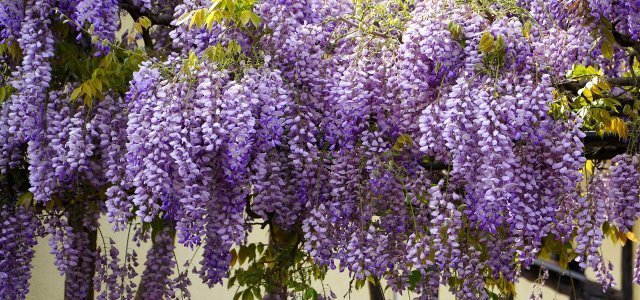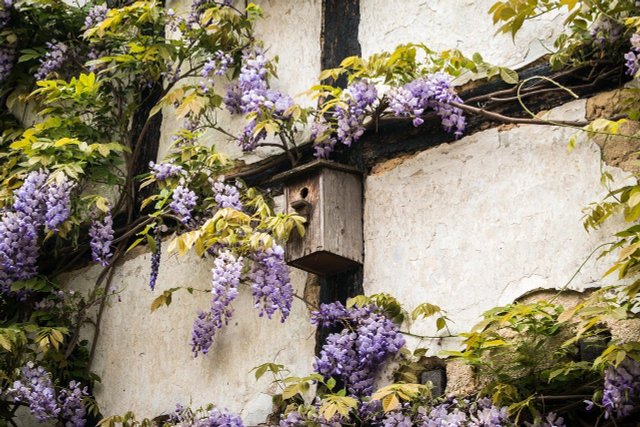
Wisteria is a magnificent flowering climbing plant that is also becoming increasingly popular in European gardens. We show you what you should consider when planting and caring for wisteria.
Wisteria is also known under the names Wisteria and Wisteria. Originally, the plant comes from East Asia and the eastern part of North America. For example, it is a popular ornamental plant in Japan. In Europe, too, Wisteria enjoys great popularity due to its splendid bloom and pleasant smell.
The climbing plant blooms in May and June. The color of the flowers varies between white, pink, purple and blue. However, Wisteria is not only visually enriching, but also a source of food for insects. The abundance of insects in turn attracts birds, which use the insects as a food source. For more tips, click here: Bird-friendly garden: Here’s what you can do to help preserve biodiversity.
Planting Wisteria : Tips and hints
The following aspects you should consider when planting the colorful flower:
Location
Wisteria grows best in a warm and sunny location. Even semi-shaded places are suitable, as long as the plant gets enough sunlight.
Also, when choosing a location, make sure that the plant has enough space. Wisteria grows up to ten meters in height.
The soil should be nutrient-rich, slightly acidic, moist and well-drained. You can determine whether your soil meets the requirements by taking a soil sample.
Planting Wisteria
- You can either buy Wisteria as a young plant or sow it yourself. Plants that you grow from seed, however, will not bloom for the first time for seven to eight years. Also, it often happens that home-grown Wisteria shrubs do not bloom at all.
- You can either plant the young plant in the garden or let it bloom in a pot on the balcony. Especially in the beginning, make sure to water the Wisteria regularly.
- If you plant wisteria in a pot, it should be large enough. The most suitable is a pot with a capacity of about 200 liters.
Since Wisteria are climbers, they need a sturdy climbing aid that they can climb up. You can build this yourself from wood, wire or branches:
Care Wisteria
- It makes sense to fertilize wisteria regularly, especially during the growth phase. As a long-term fertilizer, you can add some compost to the soil. Alternatively, you can fertilize the wisteria weekly with a little liquid fertilizer. How you can easily make your own ecological fertilizer, you can learn here: Fertilizer for plants: Make your own fertilizer naturally
- Especially the young plants should be watered regularly. The soil should always be moist, but not waterlogged.
- Wisteria is hardy and therefore does not require additional frost protection during the cold months. Just make sure to water the plant less and more intensively during this time.
Cut Wisteria

Immediately after planting, you should cut back the Wisteria for the first time. To do this, cut off the long shoots except for a few buds. This allows the plant to develop short shoots on which flower buds will form. It takes about two to three years before the plant flowers for the first time. During this time, you should first allow the Wisteria to grow a little, so that it can twine its way up the climbing support.
To ensure that the Wisteria continues to bloom vigorously and for a long time, you should then cut it back twice a year.
- It is best to cut back all side shoots to 30 to 50 centimeters in the summer, about two months after flowering. Simply break off any new shoots that emerge.
- The second pruning is done in late winter on a frost-free, overcast but dry day in late February or early March. The shoots that have already been pruned in summer are cut back to two or three flower buds. The latter are located at the lower end of the shoot and are thicker than the leaf buds.
Is Wisteria poisonous?

In all parts of Wisteria there are poisonous components. The poison of the flower affects both humans and animals. In case of poisoning, nausea, headache, drowsiness, diarrhea and vomiting, or even circulatory collapse may occur, among other symptoms.
The seed pods are particularly dangerous: they burst with a bang, ejecting their seeds. This causes the poisonous seeds to spread quickly through the garden. In addition, the popping pods are a favorite toy for children. Therefore, be sure to plant Wisteria out of the reach of children and pets.

